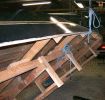

A place to share YOUR boat building story
Glen-L Marine Designs - 9152 Rosecrans Ave. - Bellflower, CA 90706
 In this issue
In this issue
- Tee Shirt Contest Winner!
- Building the Glen-L Series 1700 Trailer by Ray Macke
- Viking Ships: The Drakkar
- Tech Talk: Clinker Planking
- Luxury Yacht Diving Competition
- That Old Boat by ArtDeco
- Photos sent in since the last WebLetter...
- Calculating Maximum Boat Capacity
- Shop Talk: Applying Finishes Over Epoxy Coated Surfaces
- Recent email
- Age Is A State of Mind (?)
GLEN-L Update
- The big news in this WebLetter is that I edited it all by myself, so now there's no one else to blame. I really hope that you'll all find this edition both entertaining and worthy of your time in terms of boatbuilding substance. I know that you're all used to Barry's style, so I've tried to not put too much of my own personality into it (yet), but, watch out, my own (some call it "odd") sense of humor and personality will become more and more apparent over the next few months. That being said, please do me (and yourselves) the favor of sending me some feedback about this issue. It would be extremely helpful to hear from you what you liked, what you didn't care for, and what you think is missing in order to make this the most valuable publcation it can be for you.
- Big News! Don't tell anyone that you heard it from me, but Glen has been working on a new "Boatbuilder's Notebook" which is a complilation of many of the things you need to know when building (or thinking about building) a boat. It will cover what you need to know "without all the bells and whistles; just the basic info." From the foreward:
"This 'Notebook' is primarily slanted toward the builder or prospective builder whose interest is a plywood boat of trailerable size, power or sail. Yes, most of the information will apply to all sizes and types of boats...to make your boatbuilding project easier and subjects quicker to locate...each subject is titled and that's what's covered; not a lot of prose but simple basic condensed facts...."
I can't give you an approximate publication date for it yet, but I don't think it'll be too far down the road...I'll keep my ear to the ground and keep you updated as much as I can. - No doubt you’ve heard the latest news that the stimulus package has been signed by President Bush, so get your tax returns in and be on the lookout for a check in May or June. Everyone who files a tax return will receive a FREE $600 ($1200 for married couples, more if you have children). Since this whole exercise is designed to stimulate the economy, I hope you won't do anything unpatriotic like paying off your bills or (ugh!) saving the money for a rainy day; let's all really focus on stimulating the economy, and what better way to do so than by purchasing some Glen-L plans/supplies and building a boat! Now that's not only a stimulant to the economy, it's an investment in a lifetime of memories!
- Finally, remember that the WebLetter is prepared between other responsibilities and the finished product depends a lot on input from Glen-L builders. If you have a story to tell, don't be bashful, our readers are interested in your boatbuilding project. Don't worry about grammar, spelling, etc. Three people proofread the WebLetter and we often make corrections. Email your story, attach photos with captions. Seeing other projects is a great help to builders. Thanks so much to those of you who contributed to this WebLetter.
- West Coast Rendezvous, May 4, 2008 at Bethel Island, CA
"Bring your boat, Share the experience"
Editor
Announcing! Glen-L Tee Shirt Contest Winner
Yes, we have a winner of our recent contest to find a new Glen-L Tee Shirt design. Dennon Osterman of Toronto, Ontario, Canada is the winner with his original and classy design: click on picture to see front and back of shirt 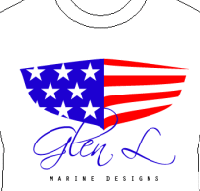
Congratulations Dennon and thank you so much for your hard work. We'll let everyone know when the new shirts are available for purchase…
In an upcoming Newsletter, we'll post photos of all the submissions that we received so we can give due recognition to all of you who contributed to this contest - I just didn't have time to do it for this issue… thank you again to all the participants!
--- Gayle
Building the Glen-L Series 1700 Trailer
Update by Ray Macke
The "Gathering" of 2007 was approaching and I was planning to attend but had a problem. For the past year or so I have been a little ashamed of my trailer. It has been a beast of burden transporting Therapy for thousands of miles yet receiving little in the way of TLC. Sure, I repacked the wheel bearings and kept the lights functional but that was about it. As the seven years have passed since new hydrated iron oxide(Fe2O3-nH2O)
Where the real problem existed was in the bunk mounts. In retrospect, this was caused by a design flaw I created in mounting the carpet covered bunk boards to the frame. As can be seen in the photo below, I cut spacers of 3" channel, which I welded on edge to the frame. On top of those I welded a flat 3/16" thick plate with a hole drilled for the galvanized carriage, which attached the treated bunk board. They looked very clean and were extremely strong.
BUT - they rusted horribly. The main reason was . . .
Viking Ships: The Drakkar
Out of the fragmented world of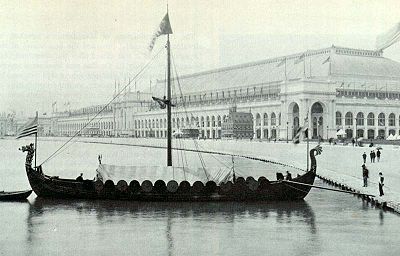 Europe in the Middle Ages, after the decline of the Western Roman Empire, several societies began to make their presence felt. One of those societies was that of the Norsemen, or more commonly known, the Vikings.
Europe in the Middle Ages, after the decline of the Western Roman Empire, several societies began to make their presence felt. One of those societies was that of the Norsemen, or more commonly known, the Vikings.
The Vikings' primary mode of transportation was a boat pulled by oarsmen. In the first millennium, these boats were small, but by the 10th century, the longboat had come into use and nothing instilled fear in the hearts of Medieval Europeans more than the sight of an approaching Viking longboat full of men ready to pillage and plunder.
The longboat had a shallow draft and could be easily sailed up shallow rivers, and ranged in size from a few dozen feet to over one hundred and fifty feet. The Vikings used the longboats to conduct raids against isolated towns and monasteries in France, Germany, and England, as well as Russia and even the Mediterranean Sea.
The Drakkar
Nothing is as symbolic of the Vikings as the longship or drakkar. Also called a dragon ship by its enemies, the drakkar was really a warship designed to carry fearless Viking warriors on their raids across Europe over a millennium ago.Luxury Yacht Diving Competition



This boat took first place at the exclusive annual Luxury Yacht Diving competition
with a spectacular forward twist. The judges gave it a very respectable 9.3, commenting that points were lost due the large size of the splash.
That Old BoatThis poem is somewhat longer than usual but that's what it took to tell this story from my boat-building past. When I was younger -- ArtDeco |
Photos sent in since the last WebLetter... |
Calculating Maximum Boat Capacity
Q UESTION: Sea Knight Maximum Capacity
I was looking over the USCG Safety Standards for Backyard Boatbuilders to get the information on max. load/person/gear. On page 6 it begins with filling the boat with water and counting the buckets full, then figuring out the weight of water it took to fill it. After searching for the part saying it was a joke, I realized they were serious.
ANSWER: We concur, the USCG method of filling the boat with water is not a practical method. They do have a method to calculate the interior volume, but it is rather complex. A short method follows that is reasonably accurate for the purpose and is on the conservative side. It assumes that the boat was built per the plans.
Plansheet 2 shows the sections of the hull in HALF SECTION.
- Strike a line parallel to the reference line at #0 (transom) sheer level. The square footage of the area below this line and inside the hull outline must be calculated at #0, #2, and #5. The drawings are to 1 inch = 1 foot scale.
- The area can be figured by dividing these areas into geometric shapes (rectangles and triangles). The area must be in SQUARE FEET.
- The simplest way to do this is to use transparent graph paper with a 1/4" square grid. Each square in scale is 3" or 16 squares per square foot.
- Lay the graph paper over the section drawing and count the squares in each of the three sections.
- Figure the area of each of the three stations.
- Add them together and multiply by 2 (2 halves).
- Multiply by 5' - The result is in cu. ft total volume.
- Mutliply the cu. ft. by 64 (weight of water)
- The final answer is the weight required to sink the boat to the sheer level.
We've taken some liberties on the conservative side as to where the sections are taken, but it's probably as accurate as filling the boat with water.
When the US Boating and Safety Act was first passed we assumed we would be required to calculate these figures for each design. We contacted the USCG to ask how we should go about this and they asked if we built the boats... no, then you cannot make the calculations. Only the builder can certify the figures as the builder may not follow the plans.
For More Information see USCG Regulations FAQs
 "All you have to do is know where you're going. The answers will come to you of their own accord." |
Shop Talk:Applying Finishes Over Epoxy Coated Surfaces
All exposed epoxy surfaces should be painted or varnished with a high ultra-violet (U-V) resistant varnish to protect the surface against potential long-term breakdown from U-V radiation, a phenomenon which occurs with all boatbuilding resins. POXY-SHIELD® provides an excellent paint base for most paints and varnishes, even though varnished coatings will still require periodic renewal. Interior areas not exposed to sunlight can be completely coated and finished with resin alone, and in many cases, this can be done PRIOR to putting interior components in the boat.
While marine paint system technology is a rapidly advancing field where direct unqualified statements may be subject to change and revision in a relatively short period, in general, just about any paint commonly used on boats can be used on boats made with the GLEN-L EPOXY ENCAPSULATION SYSTEM. These include the standard-type marine enamels, silicon/alkyd types, epoxy paints, and the one or two-part urethanes. With many marine paints, manufacturers recommend an "etching" primer over polyester or epoxy coated surfaces, with or without fiberglass.
Linear polyurethane (LP) systems can usually be applied directly over epoxy coated surfaces without primers, but they are costly and frequently have much more critical application parameters. Many brands and types of marine paints are available which are suitable for roller or brush application by the amateur. Marine paints are extremely durable, and most give a high-quality "yacht finish". Marine paints and varnishes are formulated to stand up to gasoline and other solvents found in a marine environment as well as the strong, direct and reflected, ultra-violet light. While expensive at first, marine paints may be less so over the long term because these finishes last longer in a marine environment. Remember that if your boat remains in the water for long periods, it will require an anti-fouling type bottom paint.
An alternative to marine paint systems, particularly on smaller, low budget boats, are industrial grade alkyd enamels. Like marine paints these paints may not be available in local consumer paint stores and may take some searching to find. As in all cases with various paint products, always follow the instructions provided by the paint manufacturer to the letter. lf questions arise, contact the paint manufacturer directly for his advice, since most firms have highly qualified technical staffs that will know how to answer questions.
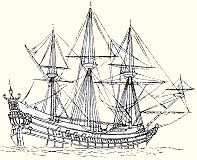
Recent email:
Subject: Quagga Mussel Danger
Date: 5 March 2008
Unfortunately, the quagga mussel also likes Casitas, and the lake may be closed to recreational boating for a year. It hasn't happened yet, and I expect that there will be a lot of discussion about this one, but the mussel infestation has become a big problem.
You might suggest in the next newsletter that folks wash out their bilges and bait tanks after leaving one lake and before launching at another.
You guys are probably aware of the problem, but I thought I'd bring it up anyway.
--- Mark Shipley
Editor's Note: As of 4 March 2008 Lake Casitas has closed to all outside boats for one year (click on Lake Casitas link above for more information).
Subject: Wooden Boat Show
Date: 21 March 2008
--- Ed Skulski, Lancaster, NY
Editor's Note: Anyone else with a Glen-L design planning on displaying or even just attending the WoodenBoat Show (in Mystic, Connecticut, June 27-29) please contact us so that we can support you in any way we can. We think it would be great fun if all the Glen-L boatbuilders could meetup sometime duing the show!
Subject: T-Shirt Contest Winner
Date: 21 March 2008
About building a boat...I just don't have the room to build it or store it. I live in San Diego and you would think that I could find the space, but...I haven't. My wife seems to think that the garage is for her car!!!!
She still hasn't seen the wisdom of making the garage a workshop...
Thank you,
--- Nick Vanmatre
Subject: T-Shirt Contest Winner
Date: 21 March 2008
--- George R Osborn
Subject: T-Shirt Contest Winner
Date: 22 March 2008
--- Ed Tobin
Subject: T-Shirt Contest Winner
Date: 21 March 2008
--- William McAvoy
Subject: The "Mac" Clamp
Date: 3 March 2008
I didn't have enough to keep me busy so I started on the Harbormaster. I may expire before it's finished, but I am having fun. All this is with no helper. I feel if I don't complete it, my grandson-in-law will finish it. He has his eye on it. But it still is fun!
I wanted to let you know that I invented a new clamp to hold the gluing of the permanent forms made from 2 x 1/4 material, as well as the stem. The clamp works like a charm and does the work of an extra hand. It is like the safety pin, though. After you see it you will say "Gosh, I could have done that!"
I made holes in the forms 8 inches apart (so that equal pressure could be applied from the starting end); as you apply a clamp the strips bend and adhere to each other. When you get to the end you have a very well formed and solid, permanent rib.
Here are some pictures of my clamps:
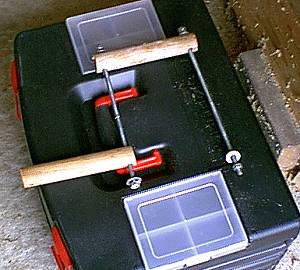 Photo #1 - I bought 3/4" hardwood dowels, drilled a hole in each end (being careful to put holes as straight and close together so that the matching ¼" threaded rods will fit).
Photo #1 - I bought 3/4" hardwood dowels, drilled a hole in each end (being careful to put holes as straight and close together so that the matching ¼" threaded rods will fit).Threaded rods cut to desired length. I put a single nut on one end and a double nut on the other end so that a drill can be applied. The purpose for this is so the drill will actuate on the double nut and a wrench can be used at the opposite end . . . at times you will have to tighten and in a moments notice back off the pressure so the double nut trick works fine.
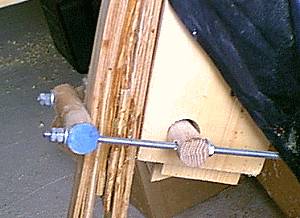
Photo #2 - An application at work. Even though you get a little glue on the top dowel, don't worry; a little tap and it releases with no after effects.
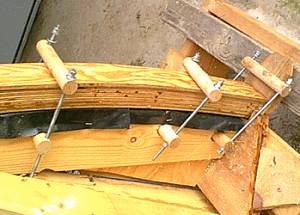
Photo #3 Here we have the one inch holes drilled in the stem form with the clamps inserted to show what can be done with a little ingenuity. Be sure to place a flat washer between the nut and the dowel to keep the nut from digging out the dowel when things get tight. Believe me, the nut will dig into the dowel and split it.
I hope I have given someone a "helping hand."
The clamps worked very well for me, and they will put QUITE a force on whatever you are clamping. Before I found that out I squeezed a rib down tight and let it set (harden) and it had a dent in it. I have been a rancher most of my life and have had at times to make a new tool to take place of one I didn't have.
Here's one for you . . . I flew back home from Wyoming one time in a single place small aircraft which had no battery, no radio, and no generator (simply because the engine had no place to install a generator). Well, I thought about that for several months; decided I would play with my pickup truck and make it run without a generator. I succeeded, drove the pickup for a month without a generator. I was going to get it patented but they wanted too much money, so I gave the idea to my grandson.
It was like building a boat … F-U-N!
H.R. "Mac" McGalliard
Texarkana, TX
Subject: The Whitehall
Date: 12 March 2008
I found the 17' Whitehall in John Gardner's book "Building Classic Small Craft." I have enough beautiful 1/8" red cedar veneer to cold mold two layers over strip, which I'd prefer to do with this next boat. Gardner's plans are for carvel, of course, so I searched for plans accommodating modern construction. I found your Whitehall design. I'm after a historical set of lines, and not after a lightweight "modern" interpretation of a Whitehall, if you know what I mean. I just was able to print your body plan and that looks pretty similar to Gardner's lines and the deadrise he claims as typical of the type.
My question is this: how faithful to the traditional Whitehall genre is your boat?
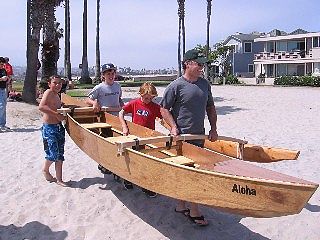 And, can you tell me more about how satisfied you are with the design? Would I be a fool not to build your Whitehall?
And, can you tell me more about how satisfied you are with the design? Would I be a fool not to build your Whitehall?Thank you.
--- Scot
P.S. I build a boat with my fifth graders each year. Here is a photo of last year's stitch and glue outrigger, which I took the panels shapes off of a model we made.
Gayle Answered Scot as follows:
"Thank you for your interest in our Whitehall design. We agree, the Whitehall is a beautiful design and I'm sure you've seen some of our customer photos of the finished boat online. This design was taken from classic designs, but not any one in particular. We are very happy with this design and would you 'be a fool not to build her?' Hmmm, of course you would!"

Subject: Wildfires
Date: 10 March 2008
We also lost our home, barn, shop, 6 cars and all farm implements and everything we own except our pickup truck and my wife's car.
You have great plans and great designs. My very first Eight Ball was stolen soon after completion but I was able to build another boat.
When I find a new home I plan to build another boat, probably a powerboat of some sort.
Kindest Regards,
--- Sam Frazier, Lazy Coyote Ranch, Ramona, CA
Subject: 11 ft. Feather "Blue Chip II"
Date: 24 March 2008
I took it upon myself to apply the t.l.c. that she badly needed. At some stage John had replaced her centreboard with small bilge keels but otherwise she is more or less as built. At least I have tried to keep it that way. It seems strange that she has no toe straps or kicking strap (boom vang to you guys!) but John assured me that she never had any. Any way I digress!
You've probably got boats all over the world, but hopefully Blue Chip ll will provide our junior section, some of whom come from under-privileged backgrounds, with sailing experience here on the River Mersey. Despite being 10 or 12 miles from the river mouth leading into Liverpool Bay, Liverpool Sailing Club is situated on a 3½ mile wide stretch of the river.
I only hope that all the hard work has given her a new lease of life!
Regards,
--- Nick Wynn-Williams, United Kingdom
Age is a State Of Mind...huh?!
The captain of the whaler found himself in need of a lookout on short notice. The ship was scheduled to return to the hunt the next day and the owner of the whaler was very demanding and unpleasant when disappointed. The captain put out the word that a sharp-eyed lookout was needed and any candidates should report to the ship that evening at 1700 hours sharp.At the appointed time the captain arrived on deck finding only one candidate onboard; a very old looking man. "How old are you?" asked the captain.
"I'm eighty years old last November and I have the sharpest eyes in town" said the old man. "Is that so?" laughed the captain. Knowing he could not read it himself, he said, "Tell me old man, what does that sign say on the dock across the bay?"
The old man said, "No fishing by order of the constable." The captain was shocked when he verified it using his telescope. That was exactly what the sign read!
"Well, that's all well and good," said the captain, "but you'll never be able to get to the crow's-nest being a man of advanced years." With that the old man took off and traversed up the mast, slapped the crow's-nest and returned to the deck in front of a totally shocked captain. "You're hired!" yelled the captain, "I have never been so impressed with a seaman than I am with you on this day. Report for duty, ready to ship out at dawn."
The next morning after the old man had reported for duty, the ship's helmsman and harpooner visited the captain's cabin and expressed concern about the captain's new hire. "He's an old man," said the harpooner, "he'll never see the whales and I'll not know where to aim!" "Yes," said the helmsman, "and he must be too feeble to climb the mast to give me a heading to steer!" "Fear not," said the captain, "That old man is one of the best candidates for lookout I have ever seen. He'll do just fine."
The whaler was out on the very next day and ready for action when the shout came from the crow's-nest, "Whaaaaale Ho!" Excitedly the captain yelled, "Great job lookout, in what direction does the whale swim?" There was no answer. Again the captain yelled, "what direction should the helmsman steer?" Still no answer came from the lookout.
Finally, after a very long pause, a soft voice drifted down from the crows-nest...
"I forget."
Build more boats
GLEN-L boats, of course




